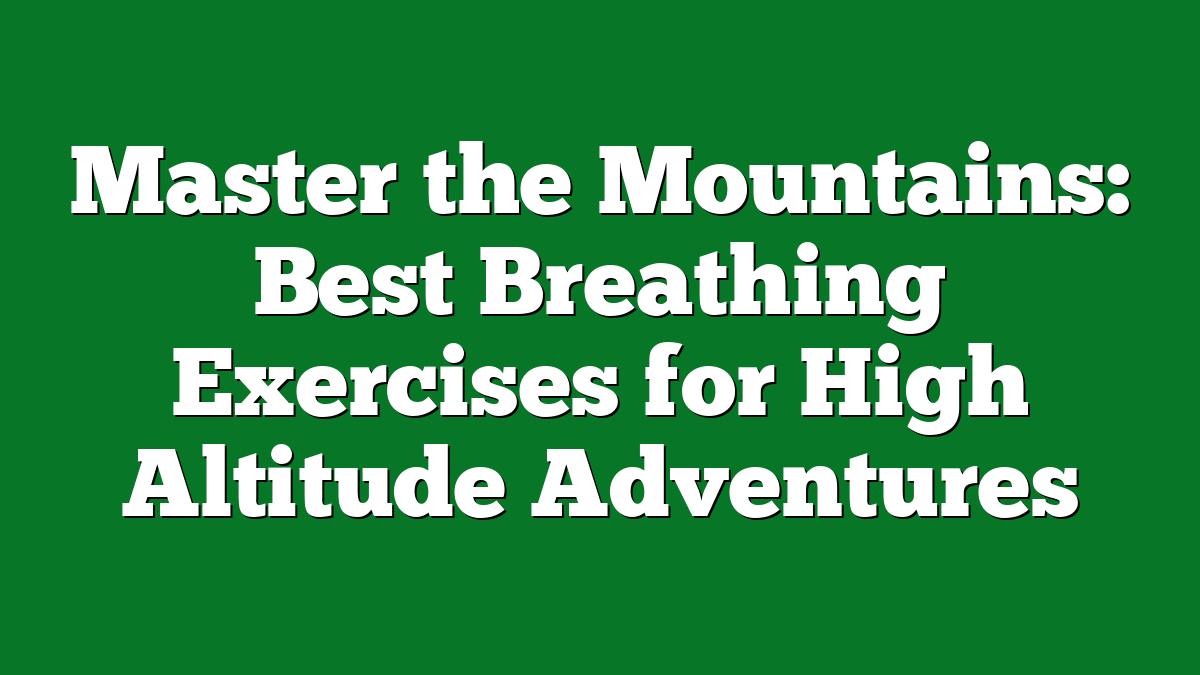Have you ever found yourself struggling to catch your breath while exploring breathtaking mountain peaks? High altitude can be both exhilarating and challenging, especially when it comes to our lungs. I’ve experienced that dizzying feeling firsthand, and it’s no fun at all. Luckily, incorporating some effective breathing exercises can make a world of difference.
Understanding High Altitude Effects
Breathing at high altitudes poses unique challenges, especially for campers and outdoor enthusiasts. Low oxygen levels can lead to various physical effects that require careful attention.
Physical Challenges at High Altitude
High altitudes often create multiple physical challenges. Oxygen levels drop, making it tougher to breathe. I’ve experienced symptoms like headaches, nausea, and fatigue during climbs. Acute Mountain Sickness (AMS) can occur when ascent happens too quickly. Symptoms of AMS include dizziness, increased heart rate, and difficulty sleeping. The body needs time to adjust, so gradual acclimatization is essential.
Importance of Breathing Techniques
Breathing techniques serve as critical tools for coping with high altitude. These techniques help maximize oxygen intake and improve overall performance. Controlled breathing aids in relaxation and reduces the impact of altitude sickness. Practicing diaphragmatic breathing expands lung capacity and enhances oxygen efficiency. Simple techniques, such as inhaling deeply through the nose and exhaling slowly through the mouth, can significantly alleviate discomfort. Implementing these strategies can elevate the camping experience, ensuring the focus stays on the adventure rather than battling altitude effects.
Best Breathing Exercises for High Altitude
When I venture into high altitudes, mastering my breathing plays a crucial role in the experience. These exercises enhance oxygen intake and support my body as it adjusts to lower oxygen levels. Here are some effective techniques.
Diaphragmatic Breathing
Diaphragmatic breathing is my go-to exercise. I place one hand on my chest and the other on my abdomen. Inhaling deeply through my nose, I focus on letting my diaphragm expand, causing my abdomen to rise rather than my chest. Then, I exhale slowly through my mouth, feeling my abdomen fall. This practice boosts lung capacity and oxygen efficiency, helping me feel more energized while hiking at higher elevations.
Pursed-Lip Breathing
Pursed-lip breathing helps me control my breath during physical exertion. I inhale deeply through my nose and then exhale slowly through pursed lips, like I’m blowing bubbles. This technique prolongs the exhale, which creates back pressure in the airways and keeps them open longer. When climbing steep trails or carrying gear, this exercise calms my breathing and optimizes the oxygen exchange, making each step feel lighter.
Box Breathing
Box breathing is another fantastic method for staying focused and relaxed at high altitude. I mentally visualize a box as I breathe. I inhale slowly for four counts, hold my breath for an additional four counts, exhale for four counts, and pause for another four counts. This rhythmic pattern balances oxygen levels and helps me maintain calmness, especially during challenging ascents or when overcoming altitude-related discomfort.
By practicing these breathing exercises, I can conquer high altitudes with confidence and fully immerse myself in the beauty of the wilderness.
Benefits of Breathing Exercises
Breathing exercises offer numerous advantages, especially when tackling high altitude challenges. These benefits can significantly enhance the outdoor experience, making activities like camping and hiking more enjoyable.
Improved Oxygenation
Improved oxygenation is a primary benefit of these breathing techniques. Ongoing practice enables my body to become more efficient at utilizing available oxygen. For instance, when I focus on diaphragmatic breathing, I expand my lung capacity and maximize oxygen intake. Research indicates that proper breath control can ultimately elevate blood oxygenation levels (source: Journal of Wilderness Medicine). This increase in oxygen can lead to sustained energy levels throughout long hikes and backpacking trips.
Enhanced Endurance
Enhanced endurance follows improved oxygenation, supporting me during physically demanding activities at high altitudes. With regular practice of pursed-lip breathing, I maintain better control of my breath during strenuous moments. This technique slows down my breathing, ensuring that I retain essential oxygen in my lungs longer. Studies show that controlled breathing not only improves stamina but also reduces fatigue (source: American Journal of Sports Medicine). As a result, I can push myself further on climbing routes or longer hikes without feeling overwhelmed.
Tips for Practicing Breathing Exercises
Practicing breathing exercises at high altitudes can significantly improve my outdoor experience. Consistency and proper technique make all the difference when tackling mountainous terrains.
Frequency and Duration
I practice breathing exercises daily, even when I’m not in the mountains. Short sessions of 5 to 10 minutes are effective for acclimatization. I focus on diaphragmatic breathing and box breathing, gradually increasing session lengths as I gain comfort and control. Fitting in exercises before and after hikes helps maximize oxygen efficiency on the trail.
Keeping a Consistent Routine
I establish a consistent routine to incorporate breathing exercises into my day. Mornings often provide quiet moments for practice, allowing me to start the day centered. Pairing exercises with other outdoor activities enhances my routine; for example, I practice pursed-lip breathing during breaks while hiking. Keeping this habit ensures I’m always prepared for high-altitude adventures, allowing me to enjoy nature without worrying about breath control.
Conclusion
Practicing these breathing exercises has truly transformed my high-altitude adventures. I’ve found that taking the time to focus on my breath not only enhances my performance but also makes my outdoor experiences so much more enjoyable.
It’s all about being mindful and consistent. Whether I’m preparing for a hike or simply enjoying the view, these techniques help me feel more in control and at ease.
So if you’re planning to explore the mountains, give these exercises a try. You’ll be amazed at how much of a difference they can make in your journey. Happy hiking and remember to breathe!











